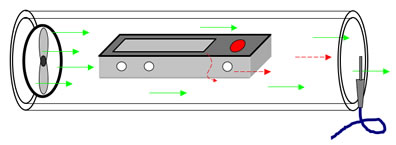|
Carrier Gas Leak Detection Using sniffer leak detectors on large objects or difficult to access test areas usually results in long test times and overall long test sequences. Using carrier gas leak detection, where the leak gas flow is transported to the leak detector by an additional carrier gas flow under atmospheric pressure, can help get the leak signal to the sniffer much faster. To illustrate how carrier gas leak detection works, let’s look at the design of a test object; an electronic box with a weld seam, an O-ring sealed lid, a lamp and three plugs. The test object is filled with tracer gas under a light overpressure. Normally, to test this object with a sniffer probe you would need to point the probe tip at all suspicious points and along the seams (see arrows).
Example 1: Integral
test chamber
The tracer gas from a leak at any point of the test object will reach the sniffer probe in approximately 2 seconds. Sensitivity of this test format is 100% because all the test gas is sucked directly into the sniffer probe. Example 2: Larger
test object and chamber
Detection of the correct leak rate needs a bit more calculation when using this configuration.

The response time is still relatively short, but sensitivity is reduced by a factor of 200 because of the high dilution of the tracer gas in the total carrier gas flow.
According to the requirements of the application, the fan speed should be carefully calibrated to optimize response time and sensitivity. |
| Forward
to a Colleague Subscribe | Contact Us | Visit INFICON Spring 2009 |
|
Leak
detection has many faces in many places. We are looking for your best
leak detection photo. Send
us a photo of you and/or your team in action with your
INFICON leak detector, and you get a cool gift!
|
| INFICON GmbH Leak Detection Tools Business Unit (LDT) Represented by managing director: Dr. Ulrich Döbler Bonner Strasse 498, D-50968 Köln, Germany |
Registered Office: Cologne Commercial Register: Local Court Cologne: HRB-Nr. 26659 VAT identification number: DE205 480 919 Ticona Information Service Tel: +49.(0)221.347.40 (Germany) Fax: +49.221.347.342414 (Germany) email: reachus@INFICON.com |
| © INFICON | |




